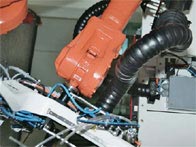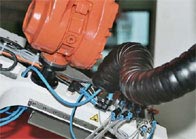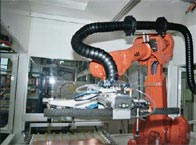Schmid Technology Systems has a new technology for the handling of circuit boards in the electronic production: A six-axis robot supplements the linear systems used until now. A Triflex® R energy chain from igus® provides the energy and signal supply for the robot's gripper.
The Schmid Group headquartered in Freudenstadt, Germany, are specialists for the design and manufacture of plants for the production of photovoltaics and circuit boards. When circuit boards, photovoltaic elements or displays are etched, laminated, removed of resin, metalized, laser cut, measured and tested or conveyed, these are frequently done by the faciltites made by Schmid. Exactly like the customers in the circuit board industry, the company is globally positioned. The several production companies who concentrate on machines and plants for individual machining operations respectively are all located in Southern Germany; sales and service are however present in North America and East Asia.
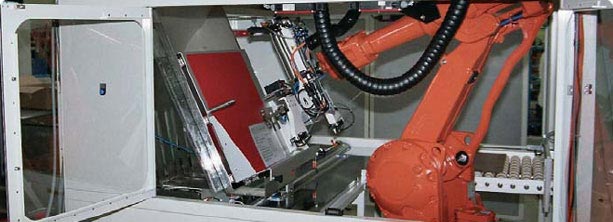
Robot handling system for circuit boards.
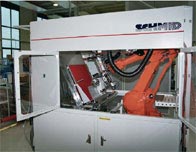
In the new circuit board handling system of the Schmid Technology Systems, a six-axis robot replaces the hitherto used linear systems. For the energy and signal supply to the robot's gripper, a "Triflex® R" energy chain from igus® is used.
The Schnid Group engages altogether about 600 employees, around 50 of them work in the Schmid Technology Systems in Niedereschach in the Eastern Black Forest. The center of excellence for the handling technology is situated there. The product range of the Schmid branch includes loading and unloading systems. These facilities separate, for example, circuit boards that are arranged in boxes and conduct them by a conveyor belt to a processing station.
More flexible, courtesy of the six-axis robot
The ever higher processing speeds and, still more important, the requirement of the customer for yet more flexibility, were the essential motivations for the development of a completely new generation of handling systems. Whereas the linear units were used so far for the movement of individual axles, a six-axis robot comes into operation for the first time now with cycle times of under seven seconds to load and unload boxes with circuit boards. Rainer Greber, Design Manager at Schmid Technology Systems: "More important than the swiftness is the flexibility of the system.
As the robot can be freely programmed, several motion patterns are possible without alterations or interventions in the hardware. " Thus for instance boxes of different angles of inclination can be loaded or unloaded, and it allows the implementation of additional variations as the system can rotate the circuit boards if required. The intermediate layers are also recognized.
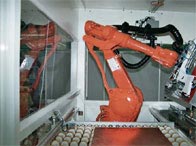
The robot takes the circuit boards from one stack provided on one of the two supply lines and deposits them on a conveyor belt.
The initial plants of this type have been delivered in the meantime. They possess two parallel collection areas, so that the robot can extract the circuit boards from the box and place them on a conveyor plate without a break. When a box is completely unloaded, it begins to unload the circuit boards from the second, while the empty box can be exchanged for a full one on the first supply line.
Additional freedom The facility is completely enclosed in a housing as the highest demands on cleanliness are placed in the handling of circuit boards. Therefore the compactness plays a major role - calculations are made in cubic centimeters in the clean room technology. For this reason the robot is sort of wedged in the machine housing, though it can freely move between the three handling areas. An interesting aspect of the plant is the gripper, which automatically identifies the size of the individual circuit board. The mounting plate with the vacuum grippers is made of low-weight carbon fibers, so that a compact 16-kg robot can be employed and handling material up to 7 kg can be moved.
Parallel to the development of the gripper, the designers at Schmid Technology Systems had to satisfy the requirement of supplying the energy, control signals and compressed air to the gripper. The robot indeed had an inner energy supply system, but which didn't have enough space for all the cables. In the search for a suitable external energy supply system, the designers came across the multidimensionally moveable energy supply system Triflex® R from igus®. This energy chain was specially designed for robotic applications. It is multidimensionally movable and suits every movement that the robot makes when it accomplishes complicated handling tasks in the sixth axis. Small bending radii create thereby the prerequisite for a space-saving installation. At the same time the exterior stop dogs for radius and torsion make sure that the defined radii is not overstepped, so that minimum bending radii are complied with, thereby ensuring a long service life for the cables.
Thus two of the essential demands on the energy supply made by the Schmid Technology Systems were fulfilled. For an additional feature, which is indispensable in this application, the Triflex® R likewise has no problem: The energy chain is made of extremely abrasion-resistant material, which possesses the necessary categorizations for the clean room technology. For all Triflex® R versions, the "igus® NB" material is used. This was already successfully tested in the energy chains Series E6 and E14 by the Fraunhofer Institute for Production Technology and Automation (IPA). Udo Gommel, graduate physicist (IPA): "The requirements with regard to cleanliness will increase further in all industrial sectors. Therefore companies like igus®, which invest early in their products, will have no problem in the future as well to hold their own in the market under these conditions. "
The individual chain links are connected to each other according to a ball-and-socket principle: This guarantees flexible movements in all directions even at high tensile strengths. The ball-and-socket principle functions similarly to the trailer coupling and necessitates no end-to-end bearing elements like steel cables or the like, so that a separation and reconnection is possible at any point in the energy chain.
igus® supplies the Triflex® R energy chain for the new handling system as ready-to-mount assembled "ReadyChain®" energy chains system, each with a servo cable and resolver cable assembled as per specifications of the manufacturer of the drive system (for both Bosch Rexroth and Indramat servo drives), two compressed air cables and a bus cable for the control signals. In the igus® production plant in Cologne, the energy chains are individually assembled each time, so that they need be only installed according to the "plug-and-play" procedure at the Schmid Technology Systems. Even the mounting plates are premounted. This "full service" concept with the igus® labeling "ReadyChain®" is also applicable for the configuration of the system: igus® experts select the chain, its length, and the mounting points in such a way that a maximum freedom of movement is guaranteed. Rainer Greber and his colleagues are happy with the result: "The configuration of the Triflex® R was done quickly and without any problems. "
In terms of wear resistance, the energy chain has set new standards in the automation in the last two and half years: They glide away over interfering edges and protect the cables effectively through their smooth interior contour. In the igus® laboratory, over one million cycles were achieved with extreme movements.
Also economically satisfying
The new handling system from Schmid Automation satisfies not only technically, but also economically. Rainer Greber: "In recent years robots have become much cheaper, and the availability of robots is notedly higher compared to the linear units. " Costs are saved even in the energy supply, for only one energy chain is necessary now instead of the six earlier.
Plastics for longer life®: Also, maintenance-free polymer plain bearings
For the new handling system, igus® (corporate mission statement: "plastics for longer life®") provides not only the energy supply system. The spindle drive of the complex gripper is supported in iglidur® bearings made of high performance plastics with durable "in-built" lubricants. This simultaneously offers several advantages compared to conventional ball bearings: One saves weight, do without separate lubrication and can be certain of having put into effect a maintenance-free, durable and abrasion-resistant bearing. At the same time none of the components releases lubricants into the environment: Thus the clean room conditions are complied with. Schmid has extensive experience with this type of bearing. In other classes of plants designed and built in Niedereschach, more than 100 iglidur® Polymer plain bearings already provide friction-less motion sequences - in the truest sense of the term...
